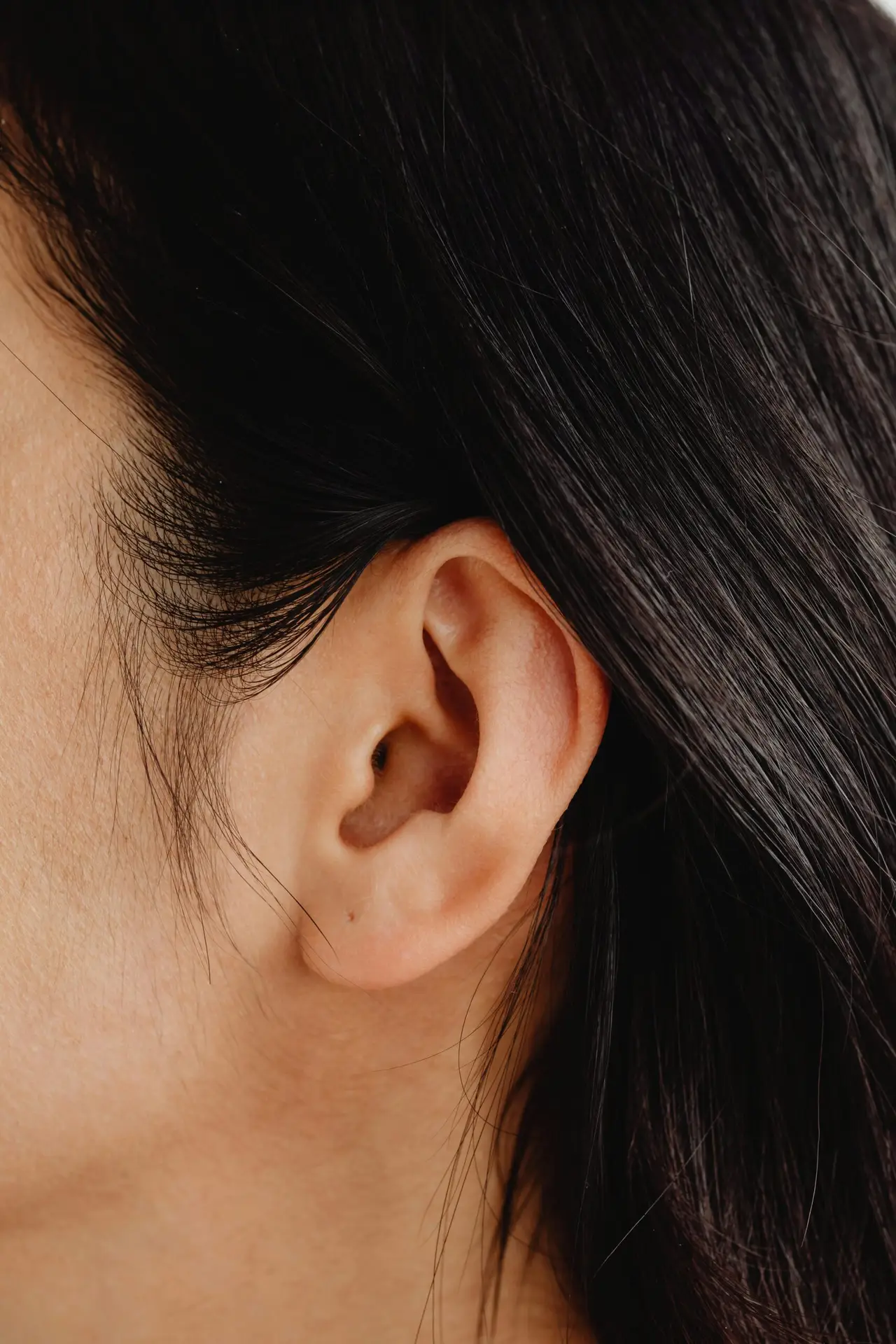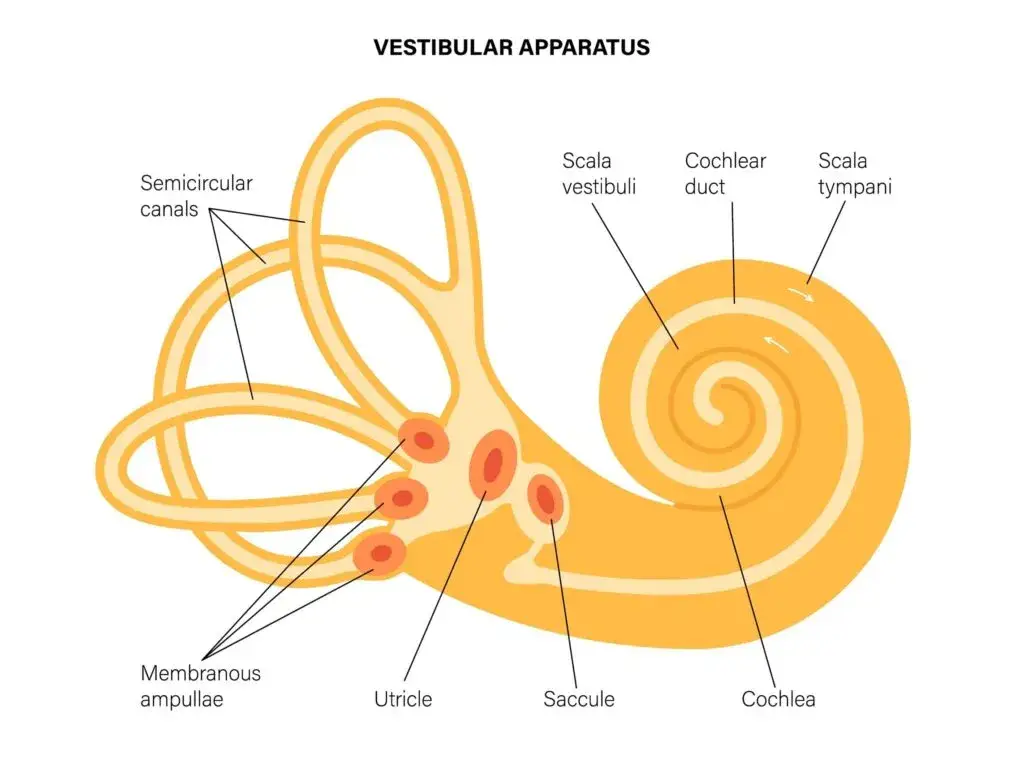
Ear Fullness and Barometric Pressure: If your ears feel stuffed, pressured, or “underwater” whenever the weather changes, you’re not imagining it. Many people in Sarasota, Bradenton, and Lakewood Ranch notice their ear fullness and dizziness spike before a thunderstorm, in airplane cabins, or even while riding a fast elevator. That heavy, muffled sensation often ties back to how your Eustachian tubes regulate pressure—and how your upper cervical spine (the top of your neck) influences that delicate system.
At Lavender Family Chiropractic in Sarasota, Florida, we specialize in upper cervical chiropractic—a precise, gentle approach that aims to restore the neuromechanical balance between your head and neck so your body can regulate pressure naturally. For countless patients, this care has been life-changing.
Below, you’ll learn what ear fullness really is, how barometric pressure plays a role, the anatomy of the Eustachian tube, and—most importantly—why upper cervical misalignment can make everything worse. You’ll also see how our advanced diagnostics (including 3D CBCT imaging and Tytron functional nervous system scans) and gentle, no-twist adjustments help you finally feel clear, balanced, and in control again.
Ear Fullness and Barometric Pressure: What Ear Fullness Actually Feels Like (and Why It’s So Frustrating)
Ear fullness is more than a mild annoyance. Patients describe it as:
- “Like someone stuffed cotton in my ears.”
- “I hear my own voice echoing.”
- “Everything sounds far away or underwater.”
- “My balance feels off, like I’m walking on a boat.”
You might also notice popping, clicking, crackling, or the urge to “clear your ears.” Some people develop headaches, facial pressure, neck tension, jaw discomfort, or dizziness/vertigo along with the clogged sensation. While infections and allergies can play a role, a mechanical pressure problem can persist even when other symptoms fade—especially during weather swings. If your ears predict rain better than your weather app, barometric pressure sensitivity is likely part of the story.
Barometric Pressure 101: Why Weather, Flights, and Elevators Trigger Symptoms
Barometric pressure is the weight of the air around us. When a storm approaches, that pressure typically drops; when skies clear, it rises. Airplanes change ambient pressure rapidly, which is why takeoff and landing notoriously affect ear comfort. Fast elevators alter pressure quickly enough to bother sensitive ears too.
Inside your middle ear (behind the eardrum) is a tiny air-filled space that must equalize with the outside world. That balancing act happens through the Eustachian tube, a narrow canal that connects your middle ear to the back of your nose and upper throat. Ideally, the tube opens briefly when you swallow, yawn, or chew, letting pressure equalize. But when the tube doesn’t open or drain properly—because it’s inflamed, congested, or not receiving the right neuromuscular signals—you get the classic stuffed, pressured feeling. Add a Florida thunderstorm to the mix and symptoms can flare quickly.
Meet the Eustachian Tube: Your Ear’s Pressure Valve
Think of the Eustachian tube (ET) as a pressure relief valve and drainage path for the middle ear. It’s lined with mucosa, opens and closes with small muscles (notably the tensor veli palatini and levator veli palatini), and is influenced by nerves originating near the upper cervical spine and brainstem. When it works, you hardly notice it. When it doesn’t, you notice everything—muffled hearing, pressure, discomfort, even imbalance.
Common reasons the ET struggles:
- Inflammation/congestion from allergies or sinus irritation.
- Poor muscle coordination that fails to open the tube effectively.
- Mechanical tension patterns involving the jaw (TMJ), palate, and upper neck.
- Autonomic nervous system imbalance, amplifying mucosal swelling and sensitivity.
- Post-injury changes (e.g., whiplash, concussion) affecting neuromuscular control.
Here’s the key insight: the muscles and mucosa of the Eustachian tube don’t work in isolation. They’re guided by the body’s neurological control center—and the upper cervical spine is the most neurologically dense structural region tied to this control.
How Upper Cervical Misalignment Fuels Ear Fullness
At the top of your spine sit the atlas (C1) and axis (C2), supporting your skull and protecting the lower brainstem. When these vertebrae shift even slightly out of optimal alignment, the body can compensate in ways that alter muscle tone, blood flow, lymphatic drainage, and autonomic balance. For ears, that can look like:
- Dysregulated ET muscle tone → the tube doesn’t open/close efficiently.
- Altered cranial/mandibular mechanics → jaw and palate tension restrict the ET area.
- Heightened sympathetic drive → more mucosal congestion and sensitivity to pressure changes.
- Impaired drainage → fluid/pressure lingers behind the eardrum, leading to fullness and popping.
Patients often say, “My sinuses are fine, but my ears always feel clogged, especially with storms.” That’s a classic clue that neuromechanical control, not just congestion, needs attention. If the ET is the valve, the upper cervical spine is part of the control panel.
Barometric Pressure Sensitivity: Why Florida Storms Make It Worse
Sarasota and the Gulf Coast experience frequent pressure swings—sea breezes, humidity surges, and summer thunderstorms. If your ET and upper cervical systems are borderline, these shifts push you over the edge. You might feel pressure hours before rain, or notice relief when a front finally passes. Air travel can produce the same push-pull: the cabin’s pressure changes faster than your ET can keep up, especially if it’s neurologically “tight” from upper neck dysfunction.
Why Pills and Quick Fixes Fall Short
Decongestants, antihistamines, and nasal sprays can be helpful for symptom flare-ups or allergies. But if the underlying problem is neuromechanical—involving ET muscle tone, jaw tension, autonomic imbalance, and neck alignment—then medications alone rarely solve it. Many patients bounce from ENT to allergy testing to endless sprays, only to find that the ear fullness always returns, particularly with storms. To break the cycle, you must restore the body’s ability to regulate pressure—and that’s where upper cervical chiropractic shines.
The Lavender Family Chiropractic Difference
At Lavender Family Chiropractic (5899 Whitfield Ave, Ste 107, Sarasota, FL 34243), our focus is upper cervical chiropractic—a specialty that uses precise analysis and gentle, targeted corrections (no popping, twisting, or cracking) to restore optimal alignment at the top of the spine. Our three-doctor team—Dr. Rusty Lavender, Dr. Jacob Temple, and Dr. Will Guzinski—combines advanced diagnostics with a compassionate, patient-centered approach that people describe as life-changing.
What sets us apart:
- 3D CBCT Imaging (Cone-Beam CT)
- We use state-of-the-art 3D CBCT to visualize your unique upper cervical anatomy. This allows us to measure subtle misalignments in millimeters and degrees, evaluate joint and airway relationships, and craft a custom correction plan tailored to your structure—because no two necks are the same.
- Tytron Functional Nervous System Scans
- Our Tytron infrared thermography measures paraspinal temperature differentials as a window into autonomic nervous system function. When sympathetic and parasympathetic balance normalizes, many patients notice cascading improvements: less ear fullness, better balance, fewer headaches, calmer sinuses, and more resilient responses to weather changes.
- Precise, Gentle Corrections
- Using an advanced upper cervical technique (including gentle, specific adjustments—no forceful twisting), we correct the misalignment that’s disrupting pressure regulation. Patients often remark how comfortable and relieving these corrections feel.
- Stabilization & Re-Training
- We don’t just “crack and hope.” We monitor objective scans and clinical changes to determine when you’re holding alignment. As your body stabilizes, Eustachian tube mechanics tend to improve, helping you tolerate storms, flights, and daily life with far fewer flare-ups.
- A Track Record of Results
- Our practice has 120+ five-star reviews from patients who share how their headaches, dizziness, ear pressure, and neck pain improved with our care. While every body is unique, many patients report that resolving upper cervical dysfunction was the missing piece after years of trial-and-error elsewhere.
How Upper Cervical Care Can Change Daily Life
Patients tell us things like:
- “I can fly again without dreading takeoff.”
- “Storm days don’t wipe me out anymore.”
- “The constant need to ‘pop’ my ears is gone.”
- “My balance and mental clarity are back.”
When the upper cervical spine is aligned, your brainstem signaling calms, your autonomic balance evens out, and the ET muscles receive clearer instructions. That means better opening mechanics, improved drainage, and less reactivity to barometric swings. In short: your body handles pressure changes the way it’s supposed to—quietly, automatically, and comfortably.
What Your First Visit Looks Like
- Conversation & History
- We’ll listen to your story—when ear pressure started, what triggers it (storms, flights, elevators), any history of concussion or whiplash, TMJ issues, sinus/allergy patterns, dizziness, migraines, or tinnitus.
- Neurological & Structural Exam
- We assess posture, balance, range of motion, and Tytron nervous system scans to identify patterns that match ET dysfunction and upper cervical imbalance.
- 3D CBCT Imaging (If Clinically Indicated)
- When appropriate, we obtain a 3D CBCT scan to intricately map your upper neck. This is the blueprint for your custom correction.
- Report of Findings
- You’ll see your images, learn what the measurements mean, and understand how your care plan addresses ear fullness and barometric pressure sensitivity from the root.
- First Gentle Correction
- We apply a precise, comfortable adjustment targeted to your unique alignment. Many patients notice immediate changes—lighter head, easier swallowing, improved balance, or clearer ears. Others feel changes build over the next several visits as the body stabilizes.
- Care Plan & Re-Checks
- We’ll outline a plan to help you hold your correction—because the true magic of upper cervical care is stability. Re-checks with Tytron and clinical assessments show progress over time.
The ET–Jaw–Neck Connection: Why TMJ and Neck Tension Matter
If you clench your jaw, grind at night, or have a history of TMJ pain, it can tug on the muscles that help open the Eustachian tube. Combine that with an upper cervical misalignment and you get a perfect storm: the ET doesn’t open well, drainage stagnates, and pressure sensitivity skyrockets. By improving upper cervical alignment, we often see jaw mechanics normalize, reducing stress on the ET area. Many patients notice less clicking, less clenching, and calmer ear pressure—especially on stormy days.
Who Benefits from This Approach?
We frequently see improvement in people who struggle with:
- Weather-related ear pressure and dizziness
- Airplane ear (trouble equalizing during flights)
- Recurring ETD symptoms despite allergy treatment
- Post-concussion or whiplash ear fullness and balance issues
- TMJ-related ear pressure or popping
- Vestibular migraine with barometric triggers
- Meniere’s-like pressure sensitivity (in coordination with medical care)
- POTS/dysautonomia with ear fullness and head pressure
Upper cervical chiropractic is not a treatment for infections or emergencies, and it’s not a substitute for appropriate medical care. But for stubborn, non-infectious ear fullness that worsens with barometric changes, it can be the missing link.
Self-Care Between Storms (Support, Not a Substitute)
These habits can support your results:
- Nasal breathing & hydration to keep mucosa healthy.
- Gentle equalization (swallowing, yawning, sipping water) rather than forceful Valsalva.
- Allergy management if applicable (saline rinses, minimizing triggers).
- Posture breaks to reduce neck tension—especially at the computer.
- Stress regulation (light walks, diaphragmatic breathing) to calm the autonomic system.
Remember: these tips help, but addressing upper cervical alignment is often what turns the corner on barometric ear pressure.
Why People Choose Lavender Family Chiropractic
- Gentle, precise, and personalized. We correct the cause—not just chase symptoms.
- Advanced imaging & scans. We don’t guess; we measure.
- Three-doctor team. Consistent, coordinated care from Dr. Rusty Lavender, Dr. Jacob Temple, and Dr. Will Guzinski.
- Local leaders in upper cervical chiropractic. Patients call us the best upper cervical chiropractor option in Sarasota, Bradenton, and Lakewood Ranch for complex issues like vertigo, headaches, TMJ, and ear pressure.
- Real stories. Our 120+ five-star reviews speak to outcomes that change daily life.
If you’ve been searching for a “chiropractor near me”, “upper cervical chiropractor near me”, “chiropractor Sarasota Florida”, “Vertigo doctor near me,” or “Migraine doctor near me,” we’re here for you.
Top 15 FAQs: Ear Fullness, Barometric Pressure & Upper Cervical Chiropractic
1) Why do my ears feel clogged before or during storms?
Barometric pressure drops ahead of storms. If your Eustachian tube can’t equalize quickly—often due to neuromuscular tension and upper cervical imbalance—pressure builds and your ears feel full.
2) Is my ear infected if it feels full?
Not necessarily. Infection can cause fullness, but many people have non-infectious ETD driven by mechanical and neurological factors. We help identify when upper cervical misalignment is part of the picture.
3) How does the upper neck affect my ears?
The atlas/axis area influences brainstem function, autonomic balance, and muscle tone near the Eustachian tube and jaw. Misalignment can create tension and poor drainage, increasing pressure sensitivity.
4) Will medications fix this problem long-term?
Medications can help symptoms, but if the root issue is neuromechanical, relief is often temporary. Upper cervical care aims to restore regulatory control, so your body manages pressure effectively.
5) What is 3D CBCT and why is it important?
CBCT gives a three-dimensional view of your unique anatomy, letting us measure subtle misalignments with precision. This guides a correction plan customized to your structure.
6) Are upper cervical adjustments safe and do they hurt?
Our adjustments are gentle and precise—no popping, twisting, or cracking. Patients typically find them comfortable and often instantly relieving.
7) How soon will I notice changes in ear fullness?
Many feel lighter, clearer, or less pressured right away; others improve over several visits as the body stabilizes. Rate of change depends on your history, severity, and how well your alignment holds.
8) Can upper cervical care help with airplane ear?
Yes—by improving ET mechanics and autonomic balance, many patients report easier equalization during takeoff and landing.
9) I have TMJ issues. Is that connected?
Often. TMJ tension can tug on the muscles that help open the ET. Optimizing upper cervical alignment can reduce jaw stress and support ET function.
10) What if allergies are part of my problem?
We respect the role of allergies and sinus care. But when upper cervical misalignment is addressed, many allergy-sensitive patients report less ear reactivity during weather swings.
11) Do I need a referral to start care?
No referral is needed. We collaborate with ENTs, dentists, and primary care providers when appropriate, especially for complex cases.
12) Will I need lots of adjustments forever?
Our goal is stability—fewer, farther-apart corrections as your body holds alignment. We measure progress with Tytron scans and clinical milestones.
13) Is this right for kids or older adults?
Yes. We tailor care to each person’s age and anatomy. Gentle, specific corrections are appropriate across the lifespan.
14) Are results guaranteed?
No healthcare outcomes can be guaranteed, but our methods are grounded in precise imaging, objective scans, and a long track record of results shared in our five-star reviews.
15) How do I get started?
Call (941) 243-3729 or visit www.chiropractorsarasotaflorida.com to schedule. We’ll listen to your story, scan for nervous system imbalance, and—if indicated—use 3D CBCT to create your custom plan.
Real-World Case Patterns We See (Names Changed for Privacy)
“Storm Season Sarah.” Each summer, Sarah dreaded afternoon storms. She’d feel ear pressure, muffled hearing, and brain fog as clouds rolled in. Decongestants helped a little, but symptoms always returned. Her exam revealed upper cervical misalignment, TMJ tension, and clear autonomic imbalance on Tytron scans. With a personalized upper cervical correction plan and stabilization check-ins, Sarah noticed that storm days felt like any other day—ear pressure calmed, mental clarity improved, and she could plan beach outings without anxiety.
“Frequent Flyer Frank.” Frank travels monthly for work and always struggled with airplane ear. Swallowing and gum helped some, but equalization remained difficult. Imaging and assessment showed an atlas misalignment with compensatory jaw tension. After gentle, precise corrections and improved stability, Frank reported significantly easier takeoffs/landings—and he stopped dreading every flight.
“Post-Whiplash Wendy.” After a minor car accident, Wendy developed stubborn ear fullness and imbalance. Medical work-ups were unremarkable. Her 3D CBCT and examination revealed upper cervical involvement. As alignment improved and her body’s autonomic balance normalized, the lingering ear pressure and dizziness receded.
Individual results vary. Upper cervical care is not a treatment for infection or emergency conditions. We collaborate with your medical providers when needed.
Why This Approach Feels So Different
Traditional care often tackles ear fullness from the outside in—sprays, pills, and procedures aimed at swelling or blockage. We certainly respect those tools. But when pressure sensitivity is driven internally by faulty neuromechanical regulation, relief tends to be short-lived. Upper cervical chiropractic works from the inside out, helping the nervous system and structures that control ET function come back into harmony. Many patients say, “This finally makes sense,” because it explains why weather, flying, posture, jaw tension, and past injuries all seem to connect.
Who We Serve
We proudly care for people across Sarasota, Bradenton, Lakewood Ranch, Parrish, Ellenton, Venice, Osprey, Punta Gorda, St. Petersburg, Siesta Key, Longboat Key, Lido Key, and Myakka City—and we welcome travelers who seek focused upper cervical care. If you’ve been searching online for chiropractor Sarasota Florida, chiropractor near me, upper cervical chiropractor near me, upper cervical chiropractic, Vertigo doctor near me, or Migraine doctor near me, you’re in the right place.
Encouragement for the Next Step
If barometric pressure controls your day, if storm clouds trigger dread, or if flights leave your ears aching and your head foggy, there is a gentle, precise, and proven path forward. You don’t have to accept ear fullness as your normal. By addressing the root cause—the way your upper neck and nervous system coordinate pressure regulation—your body can return to calm, automatic equalization.
At Lavender Family Chiropractic, we’re honored to help people regain the freedom to travel, enjoy beach days, and weather Florida’s summer storms without that heavy, clogged, disorienting feeling. Our approach is professional yet deeply personal: we listen, we measure, we correct, and we walk with you as your body stabilizes.
Lavender Family Chiropractic in Sarasota Florida offers complimentary consultations to learn more about you. Click the link below!
https://intake.chirohd.com/new-patient-scheduling/724/lavender-family-chiropractic
Visit our Website!
To learn more about us go to http://www.chiropractorsarasotaflorida.com
We also service Bradenton, Parrish, Ellenton, Ruskin, Venice, Tampa, St. Pete, Osprey, Longboat, Lakewood Ranch, Myakka City.
If you are not local, visit www.uccnearme.com to find a doctor in your area.
Ready to Feel Clear Again?
- Call: (941) 243-3729
- Visit: www.chiropractorsarasotaflorida.com
- Address: 5899 Whitfield Ave, Ste 107, Sarasota, FL 34243
- Instagram: @lavenderfamilysrq | TikTok: @drrustylavender
Lavender Family Chiropractic—serving Sarasota, Bradenton, Lakewood Ranch, Parrish, Ellenton, Venice, Osprey, Punta Gorda, St. Petersburg, Siesta Key, Longboat Key, Lido Key, and Myakka City—with life-changing upper cervical chiropractic care for ear fullness, barometric pressure sensitivity, vertigo, headaches, TMJ, and more.
When the next storm rolls in, imagine your ears staying clear and your balance steady. Let’s make that your new normal.





